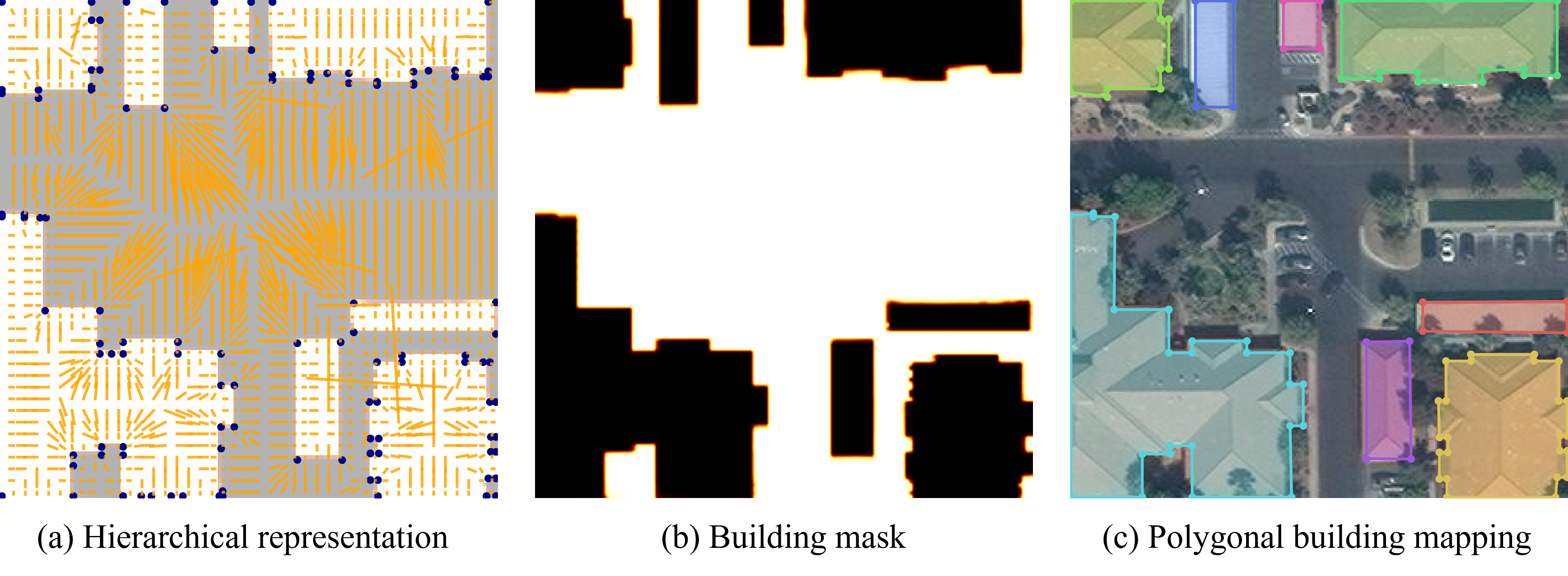Accurate Polygonal Mapping of Buildings in Satellite Imagery [arXiv]
- We address the mask reversibility issue of polygonal mapping of buildings by proposing the HiSup, which takes the hierarchical supervision signals of vertices, boundaries and masks to guide the convolutional neural network to learn in a shape-aware fashion.
- We present a key component of aggregating the embedding of attraction fields into the learning of high-level masks and the bottom-level vertices.
- We set several new state-of-the-art performances on the challenging AICrowd benchmark in terms of AP and Boundary AP by learning semantically-accurate and geometrically-precise masks.
Ubuntu-18.04, CUDA 11.0, pytorch1.7/1.8, GCC 7.3
conda create -n hisup python=3.7
conda activate hisup
conda install pytorch==1.7.0 torchvision==0.8.0 cudatoolkit=11.0 -c pytorch
cd HiSup
conda develop .
pip install -r requirements.txt
cd hisup/csrc/lib
make
For evaluation with boundary IoU, please install boundary IoU API following the installation instruction.
You can run the following command to get quickstart.
python scripts/demo.py --dataset crowdai --img [YOUR_IMAGE_PATH]
--dataset crowdai means load the model pretrained on AICrowd dataset, if you want to load the model pretrained on Inria dataset, simply change crowdai into inria.
We also provide the pretrained models with HRNetV2-W48 as backbone on AICrowd dataset and Inria dataset. You can download the pretrained models.
You can also run our demo using Colab:
- Download the train.tar.gz and val.tar.gz from AICrowd dataset
- Download the Inria dataset and put data in the inria/raw files
- Run the inria_to_coco.py from the tools file to get training data in COCO format for Inria dataset. After the generation, the training data should be in inria/train file.
The structure of the data file should be like:
/data # AICrowd dataset downloaded from website
|-- crowdai
|-- train
| |-- images
| |-- annotation.json
| |-- annotation-small.json
|-- val
| |-- images
| |-- annotation.json
| |-- annotation-small.json
|-- inria
|-- raw
|-- train
| |-- images
| |-- gt
|-- test
| |-- images
|-- train
| |-- images
| |-- annotation.json
The model with HRNetV2 as backbone are initialized with imagenet pretrained parameters. You could download them from https://github.com/HRNet/HRNet-Image-Classification and put them in the path of ./hisup/backbones/hrnet_imagenet.
Single GPU training
python scripts/train.py --config-file config-files/crowdai-small_hrnet48.yaml
Multiple GPUs training
CUDA_VISIBLE_DEVICES=0,1,2,3 python -m torch.distributed.launch --nproc_per_node=4 scripts/multi_train.py --config-file config-files/crowdai_hrnet48.yaml
python scripts/test.py --config-file config-files/crowdai-small.yaml
We provide implementation of different metrics for evaluation. You can run the following command to evaluate the test results in MS-COCO format. The prediction in json format corresponding to the validation set of AICrowd dataset is provided.
python tools/evaluation.py --gt-file [GT_ANNOTATION_FILE] --dt-file [PREDICT_ANNOTATION_FILE] --eval-type boundary_iou
This repo benefits from hawp, ECA-Net, boundary iou api, frame-field, polymapper, polyworld. We thank the authors for their great work.
